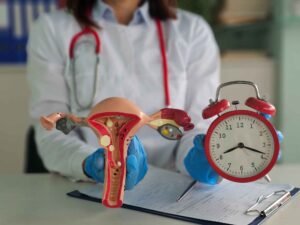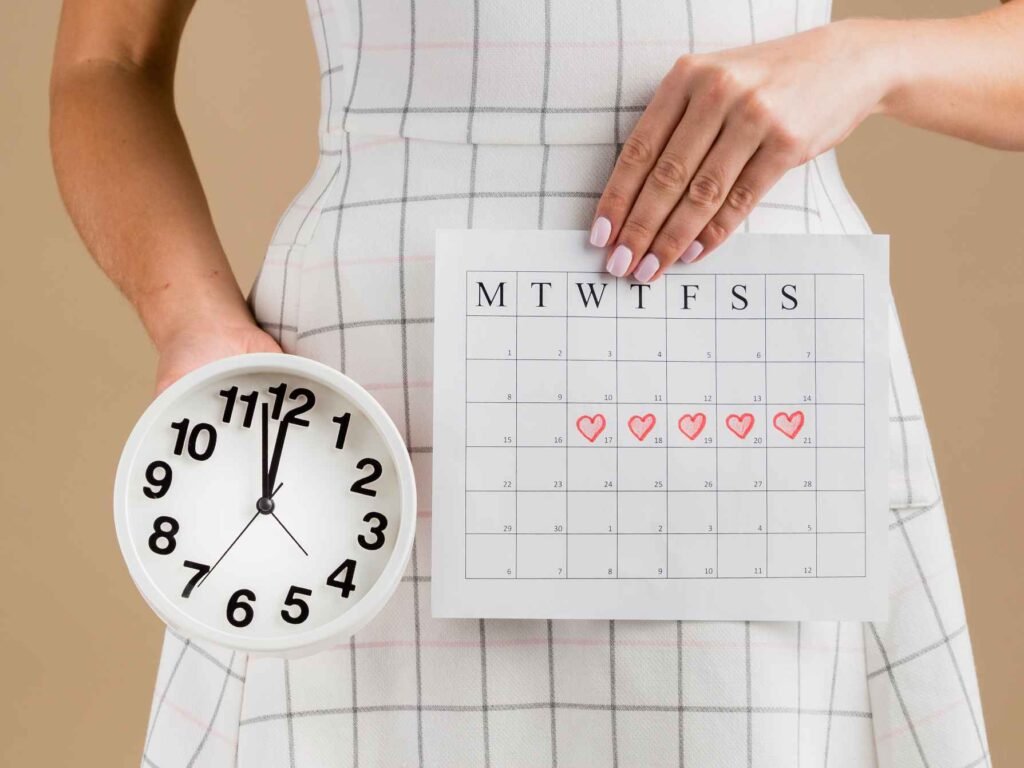Understanding Your Fertility Cycle For The Best Time to Get Pregnant
When you’re ready to start a family, understanding your fertility cycle can make all the difference. Knowing when you’re most fertile is key to increasing your chances of conceiving. But let’s face it, the world of fertility can be a bit overwhelming. From ovulation charts to basal body temperature, there’s a lot to take in. Don’t worry, though—we’re here to break it down in a way that’s easy to understand and apply. By the end of this guide, you’ll have a clear picture of the best time to get pregnant and how to track your fertility cycle effectively.
What is the Fertility Cycle?
Your fertility cycle, also known as your menstrual cycle, is a natural process that prepares your body for pregnancy each month. The cycle is typically about 28 days long, though it can range anywhere from 21 to 35 days in healthy women. It’s divided into several phases: the menstrual phase, the follicular phase, ovulation, and the luteal phase. Each of these phases plays a crucial role in your fertility and understanding them can help you pinpoint the best time to get pregnant.
The Menstrual Phase
The menstrual phase is the start of your cycle, beginning on the first day of your period. During this phase, your body sheds the lining of your uterus from the previous cycle, which results in menstruation. This phase typically lasts between three to seven days. While this might seem like the least likely time to conceive (and it is), it’s the beginning of the process that leads to ovulation, where the magic of conception happens.
The Follicular Phase
Following menstruation is the follicular phase. This phase begins on the first day of your period (overlapping with the menstrual phase) and continues until ovulation. During this time, your body is hard at work preparing an egg for release. Your brain signals the ovaries to produce follicles, each containing an immature egg. Generally, only one of these follicles will mature into an egg, which will be released during ovulation.
Ovulation: The best time to get pregnant
Ovulation is the star of the show when it comes to conception. This is the phase where the mature egg is released from the ovary and makes its way down the fallopian tube. This typically occurs around the midpoint of your cycle, about 14 days before your next period if you have a 28-day cycle. The egg is viable for about 12 to 24 hours after release, and this is the best time to get pregnant. However, because sperm can live inside the female reproductive tract for up to five days, having sex in the days leading up to ovulation can also increase your chances of conception.

The Luteal Phase
After ovulation comes the luteal phase. During this time, the follicle that released the egg transforms into the corpus luteum, which produces hormones to support a potential pregnancy. If the egg isn’t fertilized, the corpus luteum breaks down, leading to a drop in hormone levels and the start of your next period. Understanding this phase is important because it completes the fertility cycle, helping you to better predict when ovulation will occur in the next cycle.
Tracking Your Cycle For The Best Time to Get Pregnant
Knowing the phases of your fertility cycle is one thing, but how do you apply that knowledge to know the best time to get pregnant? Here are some practical methods for tracking your fertility cycle:
1. Keep a Menstrual Calendar
One of the simplest ways to track your fertility cycle is by keeping a menstrual calendar. Mark the first day of your period each month, and after a few cycles, you’ll start to see a pattern. This will help you predict when ovulation is likely to occur. Remember, ovulation typically happens about 14 days before your next period, so count backward from the expected start of your next cycle to find your most fertile days.

2. Monitor Your Basal Body Temperature (BBT)
Your basal body temperature (BBT) is your temperature when you’re fully at rest, usually taken first thing in the morning before you get out of bed. After ovulation, your BBT increases slightly due to the hormone progesterone. By tracking your BBT over several months, you can identify the subtle rise that indicates ovulation has occurred, helping you to pinpoint the best time to get pregnant in future cycles.
3. Check Your Cervical Mucus
Throughout your cycle, the consistency of your cervical mucus changes. As you approach ovulation, your cervical mucus becomes clear, stretchy, and slippery—similar to raw egg whites. This fertile-quality mucus helps sperm swim more easily to the egg. Checking your cervical mucus daily can give you a clue as to when you’re most fertile.
4. Use Ovulation Predictor Kits (OPKs)
Ovulation predictor kits (OPKs) detect the surge in luteinizing hormone (LH) that triggers ovulation. By using these kits in the days leading up to your expected ovulation, you can identify the best time to get pregnant. OPKs are especially useful if your cycle is irregular or if you’re having trouble identifying your fertile window using other methods.
5. Track Symptoms with Apps
There are numerous apps available that can help you track your menstrual cycle, BBT, cervical mucus, and other symptoms. These apps use algorithms to predict your fertile window and ovulation date based on the data you input. While they’re not foolproof, they can be a helpful tool in understanding your cycle and identifying the best time to get pregnant.
Factors Affecting Fertility
Understanding your fertility cycle is crucial, but it’s also important to recognize that other factors can affect your fertility and the best time to get pregnant. Let’s explore some of these factors:
Age and Fertility
Age plays a significant role in fertility for both men and women. Women are born with a finite number of eggs, and as they age, both the quantity and quality of these eggs decline. Fertility starts to decrease gradually in your late 20s and more significantly in your mid-30s. By the age of 40, the chances of conceiving naturally drop considerably. Men also experience a decline in fertility with age, though it’s less pronounced and typically starts later, around age 40 to 45.

Lifestyle Choices
Your lifestyle choices can have a significant impact on your fertility. Maintaining a healthy weight, eating a balanced diet, and getting regular exercise are all important for reproductive health. Conversely, smoking, excessive alcohol consumption, and high levels of stress can negatively affect your fertility and reduce your chances of conceiving during your fertile window.
Medical Conditions
Certain medical conditions can affect your fertility cycle and the best time to get pregnant. Conditions such as polycystic ovary syndrome (PCOS), endometriosis, and thyroid disorders can disrupt your menstrual cycle and make it more difficult to predict ovulation. If you suspect that a medical condition is affecting your fertility, it’s important to consult with a healthcare provider for proper diagnosis and treatment.
Timing and Frequency of Intercourse
When it comes to conception, timing and frequency of intercourse matter. Having sex every two to three days during your fertile window maximizes your chances of sperm being present when the egg is released. While timing is important, so is frequency—having sex too infrequently can lower sperm count, while having sex too frequently can reduce sperm quality. Finding a balance that works for both partners is key.
Tips to Increase Your Chances of Conception
Now that you have a better understanding of your fertility cycle and the best time to get pregnant, here are some additional tips to help increase your chances of getting pregnant:
1. Maintain a Healthy Diet
Eating a diet rich in fruits, vegetables, whole grains, and lean proteins can support reproductive health. Certain nutrients, such as folic acid, zinc, and antioxidants, are particularly important for fertility. Consider incorporating foods like leafy greens, nuts, seeds, and fish into your diet to boost your chances of conception.
2. Stay Active
Regular exercise is important for overall health and can improve fertility. Aim for moderate physical activity, such as brisk walking, swimming, or cycling, for at least 30 minutes most days of the week. However, be cautious of excessive exercise, as it can disrupt your menstrual cycle and reduce fertility.
3. Manage Stress
High levels of stress can interfere with your fertility cycle and make it more difficult to conceive. Practice stress-reducing techniques such as yoga, meditation, deep breathing exercises, or spending time in nature. Finding ways to relax and unwind can improve your overall well-being and support your journey to conception.

4. Avoid Harmful Substances
Smoking, alcohol, and recreational drugs can all negatively affect your fertility and the best time to get pregnant. If you’re trying to get pregnant, it’s important to avoid these substances altogether. Even secondhand smoke can have an impact, so create a smoke-free environment to support your reproductive health.
5. Consider Prenatal Vitamins
Prenatal vitamins aren’t just for pregnant women—they can also be beneficial for women trying to conceive. A daily prenatal vitamin that contains folic acid, iron, and other essential nutrients can help prepare your body for pregnancy and reduce the risk of certain birth defects.
6. Consult a Healthcare Provider
If you’ve been trying to conceive for a while without success, it may be time to consult a healthcare provider. They can perform tests to evaluate your fertility and identify any potential issues that may be affecting your ability to conceive. In some cases, fertility treatments such as medication, intrauterine insemination (IUI), or in vitro fertilization (IVF) may be recommended.
Understanding the Male Fertility Cycle
While much of the focus on fertility is often placed on the female cycle, it’s important to remember that male fertility plays a crucial role as well. Unlike women, who have a cyclical fertility pattern, men produce sperm continuously. However, sperm quality can vary throughout the day and across different seasons.
Sperm Production and Quality
Sperm production takes about 74 days, and during this time, various factors can influence sperm quality, including diet, stress, and environmental factors. It is most fertile in the morning and during the cooler months, which might be worth considering when planning for the best time to get pregnant. To maximize sperm quality, men should maintain a healthy lifestyle, avoid tight-fitting underwear, and limit exposure to heat sources like hot tubs and saunas.
Timing Intercourse
Just as with women, timing intercourse is crucial for conception. While men produce sperm continuously, sperm count and quality are highest after a period of abstinence lasting about two to three days. However, too long of a gap between ejaculations can lead to older, less motile sperm, so regular intercourse throughout the fertile window is recommended.

Myths About the Best Time to Get Pregnant
There are many misconceptions about the best time to get pregnant, which can lead to confusion and frustration. Let’s clear up some of the most common myths:
Myth 1: You Can’t Get Pregnant on Your Period
While it’s less likely to conceive during your period, it’s not impossible. Sperm can live in the female reproductive tract for up to five days, so if you have a shorter cycle and ovulate soon after your period, there’s a chance that sperm from period intercourse could fertilize an egg.
Myth 2: You’re Most Fertile on the Day of Ovulation
While the day of ovulation is indeed one of the best times to conceive, your fertile window actually begins several days before ovulation. Sperm can survive for several days, so having sex in the days leading up to ovulation can increase your chances of conception.
Myth 3: You Can Only Get Pregnant on the Day You Ovulate
Ovulation is crucial for conception, but as mentioned earlier, the fertile window extends beyond the day of ovulation. Sperm can live inside your body for several days, meaning you can get pregnant from intercourse that occurs a few days before you ovulate.
Myth 4: Stress Doesn’t Affect Fertility
Stress can indeed affect your fertility and the best time to get pregnant. High levels of stress can disrupt your menstrual cycle, making it harder to predict ovulation and your fertile window. Additionally, stress can impact sperm quality in men. Managing stress through relaxation techniques and a healthy lifestyle is important for optimizing fertility.
Myth 5: Timing Intercourse Too Frequently or Infrequently Is Fine
Finding the right balance of timing intercourse is key. Too frequent intercourse can lead to lower sperm quality, while too infrequent can result in lower sperm count. The optimal approach is to have sex every two to three days throughout your fertile window to maximize your chances of conception.
Increase Your Chances of Pregnancy
Understanding your fertility cycle is a powerful tool when trying to conceive. By knowing the phases of your cycle and using various methods to track your fertile window, you can significantly increase your chances of getting pregnant. Remember, the best time to get pregnant is during the days leading up to and including ovulation. However, factors such as age, lifestyle, and overall health also play a crucial role in fertility.
If you’re feeling overwhelmed or struggling to conceive, don’t hesitate to reach out to a healthcare provider. They can offer guidance, run tests, and recommend treatments if necessary. Fertility is a complex topic, but with the right knowledge and support, you can navigate your journey to conception with confidence.


